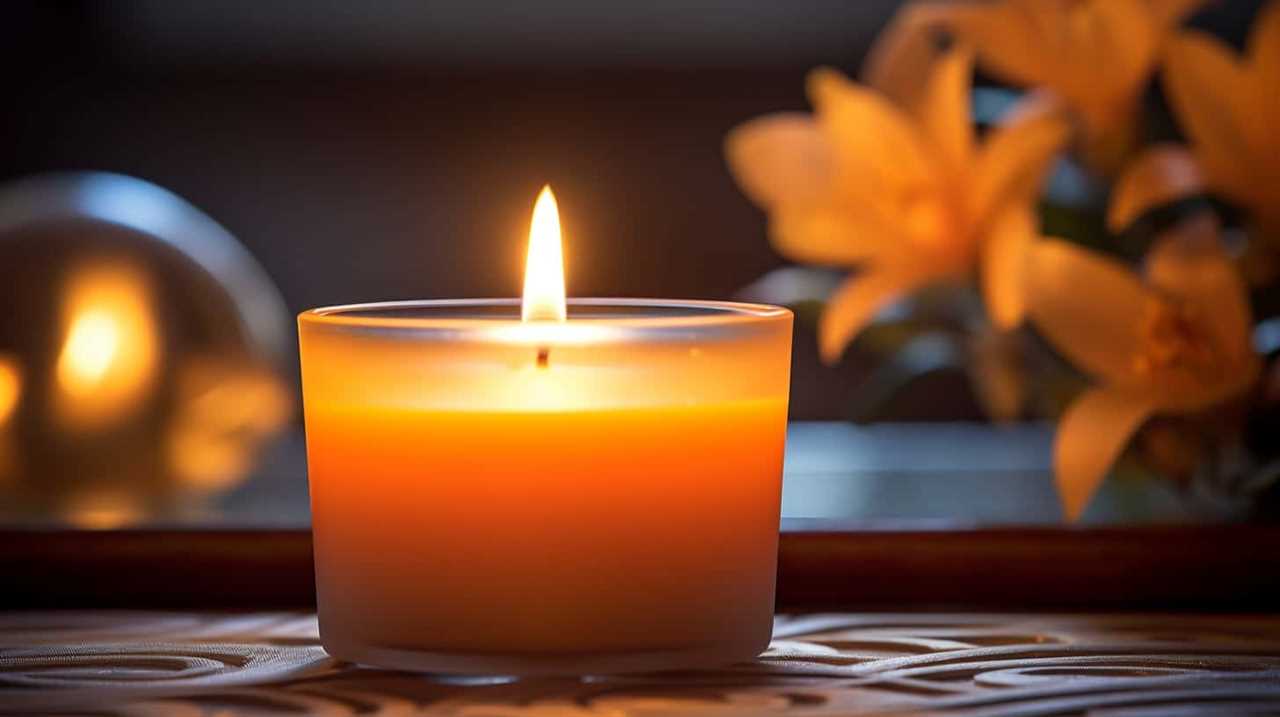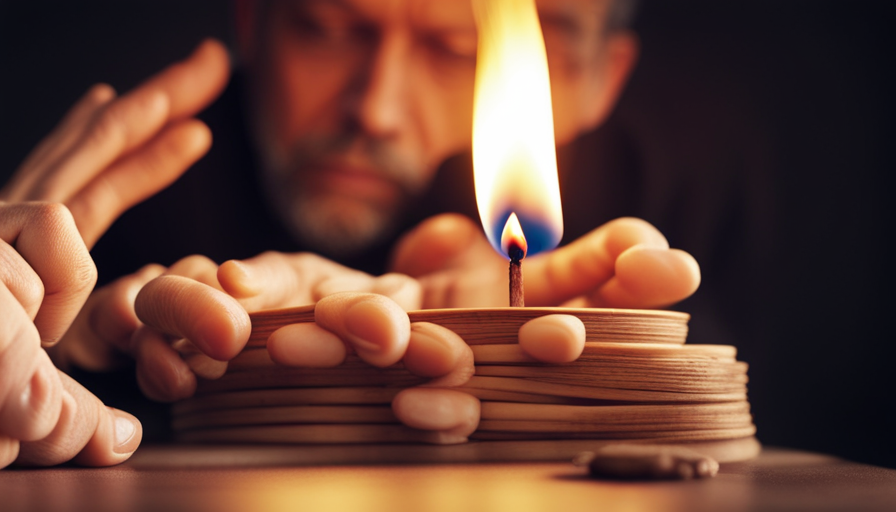Did you know that candles are considered one of the best gifts for any occasion? A recent survey found that 70% of people have received a candle as a gift at least once in their life. Whether it’s for birthdays, holidays, or just to show your love, giving a candle with a beautiful packaging adds to its meaning, making the gift even more memorable.
In this article, I will guide you through the process of wrapping a candle step by step. From choosing the right materials to adding your personal touch, I’ll provide all the information you need to create beautifully wrapped candles every time.
First, we’ll start by selecting the perfect candle and wrapping materials. Then, I’ll show you how to prepare the candle and measure and cut the wrapping paper.
Next, we’ll move on to wrapping and securing the paper around the candle. I’ll also share tips on protecting the candle during transportation and adding personal touches like ribbons or handwritten notes.
Finally, we’ll discuss how to present your wrapped candle and store it properly to maintain its beautiful wrapping.
So let’s get started and make your next gift-giving experience extra special with beautifully wrapped candles!
Key Takeaways
- Choosing the right materials and candle is important
- Wrapping materials should complement the candle and surroundings
- Different designs can personalize the gift
- Secure wrapped candle in sturdy box during transportation
Choose the Right Candle and Wrapping Materials
Now that you’ve decided to wrap a candle, you’ll need to choose the perfect candle and wrapping materials to make it truly special.
When it comes to candle wrapping techniques, there are plenty of options to explore. To start, consider the type of candle you want to wrap. Whether it’s a traditional pillar candle or a scented jar candle, pick one that suits the occasion or the recipient’s taste.
Next, think about the theme or style you want to convey with your wrapping. There are so many unique candle wrapping ideas out there – from elegant ribbons and bows for a sophisticated look, to rustic twine and dried flowers for a more natural feel.
When selecting your wrapping materials, keep in mind that they should complement both the candle and its surroundings. Look for high-quality papers or fabrics that will enhance the overall presentation. Consider incorporating colors or patterns that match the occasion or reflect the recipient’s personality.
Now that you have chosen your candle and wrapping materials, let’s move on to preparing the candle for wrapping by creating a smooth surface for adhering any decorations or protective layers.
Prepare the Candle for Wrapping
First, gather all the necessary materials to make your candle gift look absolutely stunning. To prepare the candle for wrapping, you’ll need the following items:
-
Choosing the right wrapping paper: Select a paper that complements the theme or occasion of your gift. Consider using a festive pattern or a solid color that matches the recipient’s preferences.
-
Adding embellishments: Enhance the presentation of your wrapped candle by incorporating decorative elements such as ribbons, bows, or twine. These details can add an extra touch of elegance and personalization.
-
Securing with tape or adhesive: Use clear tape or adhesive to secure the wrapping paper in place around the candle. Make sure it’s neatly folded and tightly sealed to prevent any damage during transportation.
With these materials at hand, you can now move on to measure and cut the wrapping paper to fit your candle perfectly. This step will ensure a clean and polished look for your finished gift without any excess material hanging loose.
Measure and Cut the Wrapping Paper
When preparing to wrap a candle, it’s important to measure both the height and circumference of the candle. This will ensure that you cut the wrapping paper to the appropriate size.
By taking accurate measurements, you can create a professional-looking wrap that fits snugly around the candle.
Measure the height and circumference of the candle
To get started, simply size up the candle by measuring its height and circumference. This step is crucial in ensuring that you choose the right materials for wrapping and decorating the candle.
Start by measuring the height of the candle from top to bottom using a ruler or tape measure. Next, measure the circumference by wrapping a flexible measuring tape around the thickest part of the candle.
These measurements will help you determine how much wrapping paper and other materials you’ll need. Once you have these measurements, it’s time to move on to the next step: cutting the wrapping paper to the appropriate size.
By accurately sizing up your candle, you’re setting yourself up for success in creating a beautifully wrapped gift or decorative piece.
Cut the wrapping paper to the appropriate size
Make sure you’ve accurately measured the height and circumference of your candle before cutting the wrapping paper to ensure a perfect fit. To do this, you can use various measuring techniques such as a ruler or measuring tape. Once you have the measurements, it’s time to cut the wrapping paper. Consider using different wrapping paper designs to add a personal touch to your gift. To make it easier, I have provided a table below with two columns and four rows in markdown format:
| Height (inches) | Circumference (inches) | |
|---|---|---|
| Candle 1 | 5 | 8 |
| Candle 2 | 7 | 10 |
| Candle 3 | 10 | 14 |
| Candle 4 | 6 | 12 |
Using these measurements as a guide, carefully cut the wrapping paper according to the size needed for your specific candle. With the right dimensions, you can now move on to wrap the candle securely.
Now let’s move on to how to wrap the candle without any complications.
Wrap the Candle
Wrap the candle in a creative and fun way to add a personal touch to your gift-giving. There are various candle wrapping techniques and creative ideas that can make your gift stand out.
Here are some tips to help you wrap your candle beautifully:
-
Use decorative tissue paper or fabric. Choose colorful tissue paper or patterned fabric to wrap the candle. This will add visual interest and make the gift more appealing.
-
Tie with ribbon or twine. Secure the wrapping paper around the candle by tying it with a beautiful ribbon or rustic twine. This not only adds an elegant touch but also keeps the wrapping paper in place.
-
Embellish with charms or beads. Add some extra flair by attaching small charms or beads to the ribbon or twine. This adds a unique and personalized touch to your wrapped candle.
-
Include a handwritten note. Write a heartfelt message on a small card and attach it to the wrapped candle. This will show the recipient how much thought you put into their gift.
Once you’ve wrapped the candle, it’s time to secure the wrapping paper to ensure everything stays in place.
[Transition sentence]Secure the Wrapping Paper
To secure the wrapping paper on a candle, I use tape or glue to secure the edges of the paper. This helps to ensure that the paper stays in place and doesn’t unravel.
Additionally, I make sure to smooth out any wrinkles or creases in the paper for a clean and polished look. By following these steps, I can create a beautifully wrapped candle that’s ready to be gifted or displayed.
Use tape or glue to secure the edges of the wrapping paper
Using tape or glue to secure the edges of the wrapping paper is like adding a protective shield, ensuring that your candle gift remains beautifully packaged until it’s ready to be revealed.
When it comes to choosing between tape and glue, both options have their pros and cons. Tape is quick and easy to use, providing a strong hold without damaging the paper. On the other hand, glue offers a more seamless finish, but it requires time for drying and may leave residue on the paper.
To prevent tearing or coming loose during transportation, here are some helpful tips:
1) Use double-sided tape for an invisible seal.
2) Apply glue sparingly along the edges.
3) Reinforce corners with extra tape or glue.
Once you’ve securely sealed the edges, you can move on to smooth out any wrinkles or creases in your wrapping paper.
Smooth out any wrinkles or creases
Achieve a flawless and elegant presentation by gently gliding your hand over the paper, erasing any imperfections and leaving behind a perfectly smooth surface that will captivate the recipient.
To create a professional-looking wrapped candle, it’s essential to smooth out any wrinkles or creases on the wrapping paper. Start by carefully unfolding the paper and laying it flat on a clean surface. Use your fingertips to press down along the edges of the candle, removing any air bubbles or unevenness. Work from one end of the candle to the other, ensuring that there are no visible folds or bumps.
Remember to avoid using too much wrapping paper as this can lead to excess bulkiness and make it difficult to achieve a smooth finish.
With a flawlessly wrapped candle in hand, let’s move on to adding decorative elements that will enhance its overall appearance.
Add Decorative Elements
Enhance the visual appeal of your wrapped candle by incorporating charming decorative elements. One way to achieve this is by using decorative candle holders. These holders not only provide a sturdy base for your candle, but they also add a touch of elegance and style. Choose from a variety of designs and materials, such as glass, metal, or ceramic, to complement the theme or occasion.
Another way to elevate the look of your wrapped candle is by embellishing it with ribbon. Securely wrap a colorful ribbon around the base of the candle or create intricate bows to give it a festive feel. You can also experiment with different types of ribbons, like satin or organza, for a more textured effect.
To further enhance the overall aesthetic, consider adding other decorative elements such as dried flowers, glitter, or small charms. These can be glued directly onto the wrapping paper or tied onto the ribbon for an added touch of whimsy.
Now that you have adorned your wrapped candle with these delightful decorative elements, it’s time to ensure its safe arrival during transportation without compromising its beauty. To accomplish this, carefully place the wrapped candle in a sturdy box and secure it with packaging materials such as bubble wrap or tissue paper.
Incorporating charming decorative elements elevates your wrapped candle’s appearance while protecting it during transportation.
Protect the Candle During Transportation
To ensure the safe arrival of your beautifully decorated candle, it’s important to take proper precautions during transportation.
Candle wrapping techniques vary depending on the shape and size of the candle. For pillar candles, wrap them tightly in bubble wrap or foam padding to protect them from any potential damage.
To safeguard taper candles, consider using a padded box or tube that fits securely around them.
For jar candles, use tissue paper or bubble wrap to cushion them inside their container.
When shipping delicate candles, there are a few tips to keep in mind. Firstly, choose a sturdy shipping box that provides ample space for additional cushioning materials. Secondly, fill any gaps within the box with packing peanuts or crumpled newspaper to prevent movement during transit. Lastly, clearly label the package as fragile and consider purchasing insurance for added protection.
By following these candle wrapping techniques and shipping tips, you can ensure that your delicate creations arrive safely at their destination.
Now let’s move on to considering how you can add a personal touch when giving these wrapped candles as gifts without writing ‘step’.
Consider Adding a Personal Touch
When it comes to wrapping a candle, there are many ways to make it stand out. In the previous section, we discussed how important it is to protect the candle during transportation. Now, let’s move on to adding a personal touch to your wrapped candle.
Personalizing a gift can make it even more special and memorable for the recipient. There are countless personalized gift ideas that you can incorporate into your candle wrapping. One creative idea is to create a custom label or tag with the recipient’s name or a meaningful message. You could also consider using their favorite colors in the wrapping paper or adding small decorative elements that reflect their personality or interests.
To give you some inspiration, here is a table showcasing different creative wrapping techniques for candles:
| Technique | Description |
|---|---|
| Ribbon Wrap | Use colorful ribbons of various widths and textures to wrap around the candle in an intricate pattern. |
| Wax Dipping | Dip one end of the candle in colored wax for an ombré effect that adds depth and visual interest. |
| Paper Cutouts | Create delicate paper cutouts in shapes like flowers or stars and attach them to the wrapped candle. |
By incorporating these personalized gift ideas and creative wrapping techniques, you can create a stunningly wrapped candle that will surely impress the recipient. Now, let’s move on to how to present the wrapped candle in an elegant way without any further delay.
Present the Wrapped Candle
Make your gift presentation extra special by showcasing the beautifully wrapped candle in a creative and elegant way. Here are some ideas for presenting the wrapped candle:
-
Place the wrapped candle in a decorative gift box, complete with a satin ribbon and a personalized message card. This adds an element of surprise and anticipation to the gift.
-
Arrange several wrapped candles of different sizes on a tiered cake stand. This not only creates an eye-catching display but also allows the recipient to easily choose their favorite scent or design.
To further elevate your gift presentation, consider these unique ways to showcase a wrapped candle:
-
Create a mini vignette by placing the wrapped candle alongside other small items like dried flowers, seashells, or crystals. This adds texture and visual interest to the overall presentation.
-
Hang the wrapped candle from a minimalist macrame holder or attach it to a rustic wooden board using decorative clips. This unconventional way of displaying the candle will surely leave a lasting impression.
By presenting your wrapped candle with creativity and thoughtfulness, you can make it even more memorable for the recipient.
In the next section, we will discuss how to store and maintain the candle’s wrapping without compromising its beauty.
Store and Maintain the Candle’s Wrapping
After presenting the beautifully wrapped candle, it is important to know how to properly store and maintain its wrapping. This will ensure that the candle remains protected and the presentation stays intact for future use or gifting.
To store the candle, find a cool and dry place away from direct sunlight. Extreme temperatures can cause the wax to melt or warp, while sunlight can fade or damage the wrapping. A cupboard or drawer would be an ideal storage spot.
Maintaining the candle’s wrapping involves some simple steps. First, avoid touching the wrapping with dirty hands as this could leave stains or smudges. If any dirt does get onto the wrapping, gently wipe it off with a clean cloth.
Secondly, be careful when handling and transporting the wrapped candle to prevent any accidental tears or damages. Treat it with care and store it in a box if necessary for added protection.
By following these guidelines, you can ensure that your wrapped candle stays pristine until it is ready to be used or gifted again.
Frequently Asked Questions
How do I choose the right candle for wrapping?
When choosing the right candle for wrapping, it’s important to consider the size and shape of the candle. Look for candles that have a smooth and even surface, as this will make it easier to wrap them without any wrinkles or creases.
Additionally, consider the color and design of the candle, as these factors can contribute to the overall aesthetic of your wrapped creation. Get creative with your candle wrapping ideas by incorporating different materials like ribbons, lace, or decorative paper to add an extra touch of elegance or personality.
Can I use any type of wrapping paper to wrap a candle?
Sure, you could use any type of wrapping paper to wrap a candle. But let’s be real, if you’re gonna go through the trouble of learning about candle wrapping techniques and creative candle wrapping ideas, why not take it up a notch? Opt for tissue paper with delicate designs or handmade paper with intricate patterns. Trust me, your candles’ll thank you for the extra effort.
Should I remove the label or packaging from the candle before wrapping it?
When wrapping a candle, it’s generally best to remove the packaging rather than the label. The label adds aesthetic value and provides important information about the candle. To avoid damaging either the label or packaging, here are some tips:
- Use tissue paper or bubble wrap as a protective layer and secure it with tape or ribbon.
- If necessary, use a gift box.
- Remember to handle the candle carefully throughout the wrapping process to preserve its appearance.
What is the best way to secure the wrapping paper around the candle?
To secure the wrapping paper around the candle, there are several securing techniques you can use.
One option is to tie a ribbon or twine around the paper, making a neat bow on top.
Another technique is to use adhesive tape or glue dots to hold the edges of the paper together.
If you prefer not to use traditional wrapping paper, alternative materials like tissue paper or fabric can also be secured using these techniques for a unique and creative touch.
How can I protect the candle from melting or getting damaged during transportation?
To protect the candle from melting or damage during transportation, there are a few key techniques and materials to consider.
One interesting statistic to paint a picture is that candles can melt at temperatures as low as 140°F (60°C).
To prevent this, it’s crucial to use protective materials like bubble wrap or foam padding.
Additionally, placing the wrapped candle in a sturdy box with enough space for cushioning will further ensure its safety.
Conclusion
In conclusion, wrapping a candle is like dressing it up in a beautiful gown, ready to be admired and cherished. With the right materials and techniques, you can ensure that your candle stays safe during transportation and maintains its elegant appearance.
Adding a personal touch to the wrapping will make it even more special for the recipient. So go ahead, let your creativity shine, and present your wrapped candle like a precious gem waiting to be discovered.
Don’t forget to store and maintain the candle’s wrapping with care, so that its beauty lasts for years to come.









